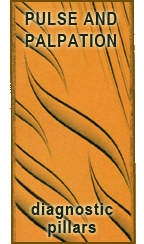Archive for the ‘Diagnosis’ Category
The Purple Tongue Body

Indications of coating variations of the purple tongue body.
 Last modified: August 16, 2009 ·
Last modified: August 16, 2009 ·  al ·
al ·  No Comments
No Comments
 Tags: Diagnosis, Observation · Posted in: Tongue-Observation
Tags: Diagnosis, Observation · Posted in: Tongue-Observation
The Pale or Pink Tongue Body

Indications of Coating Variations of the Pale or Pink Tongue Body.
 Last modified: August 16, 2009 ·
Last modified: August 16, 2009 ·  al ·
al ·  No Comments
No Comments
 Tags: Diagnosis, Observation · Posted in: Tongue-Observation
Tags: Diagnosis, Observation · Posted in: Tongue-Observation
The crimson (red-purple) tongue body

Indications associated with the coating variations of the crimson (red-purple) tongue body.
 Last modified: August 16, 2009 ·
Last modified: August 16, 2009 ·  al ·
al ·  No Comments
No Comments
 Tags: Diagnosis, Observation · Posted in: Tongue-Observation
Tags: Diagnosis, Observation · Posted in: Tongue-Observation
The Red Tongue Body

Indications of coating variations of the red tongue body.
 Last modified: August 16, 2009 ·
Last modified: August 16, 2009 ·  al ·
al ·  No Comments
No Comments
 Tags: Diagnosis, Observation · Posted in: Tongue-Observation
Tags: Diagnosis, Observation · Posted in: Tongue-Observation
Simple Pulse Qualities: Tension

Tension: slack-taut For those who’ve studied pulse diagnosis already, the “taut” pulse is what we’d call “wiry” or its many other translations such as taut, string-taut, bowstring, etc.
 Last modified: August 15, 2009 ·
Last modified: August 15, 2009 ·  al ·
al ·  No Comments
No Comments
 Tags: Diagnosis, Palpation · Posted in: Pulse Class, Pulse-Palpation
Tags: Diagnosis, Palpation · Posted in: Pulse Class, Pulse-Palpation
Ten Asking Song

It can be difficult to remember all the questions that one needs to ask during a diagnostic interview.
Long ago, the Chinese came up with a song that asks ten questions. We’ve long since lost the melody, but the words remain.
 Last modified: August 15, 2009 ·
Last modified: August 15, 2009 ·  al ·
al ·  No Comments
No Comments
 Tags: Diagnosis, inquiry · Posted in: Inquiry
Tags: Diagnosis, inquiry · Posted in: Inquiry
The Floating, Superficial Pulse (Fu Mai)

Floating Pulse (浮脈 Fu Mai, superficial) Key point: superficial, Indications: exterior condition: defensive yang mobilizes externally bringing with it the qi and blood, resulting in the floating pulse.
 Last modified: August 14, 2009 ·
Last modified: August 14, 2009 ·  al ·
al ·  No Comments
No Comments
 Tags: Diagnosis, Practitioners · Posted in: Pulse Class, Pulse-Palpation
Tags: Diagnosis, Practitioners · Posted in: Pulse Class, Pulse-Palpation
The Qualities of Qi in Meridian diagnosis
Chinese and traditional East Asian medicine can use tactile sensations to obtain at diagnostic information. This page describes the sensations of qi.
 Last modified: August 14, 2009 ·
Last modified: August 14, 2009 ·  al ·
al ·  No Comments
No Comments
 Tags: Channel, Diagnosis, Theory · Posted in: Diagnosis
Tags: Channel, Diagnosis, Theory · Posted in: Diagnosis
The Submerged, Deep Pulse (Chen Mai)

Submerged Pulse (沉脈 Chen Mai, deep)Key point: deep. Indications:(Forceful) interior excess condition: excessive pathogenic factors obstruct the outward and upward movement of the qi, blood, and yang.
 Last modified: August 13, 2009 ·
Last modified: August 13, 2009 ·  al ·
al ·  No Comments
No Comments
 Tags: Diagnosis, Practitioners · Posted in: Pulse Class, Pulse-Palpation
Tags: Diagnosis, Practitioners · Posted in: Pulse Class, Pulse-Palpation
The Confined, Firm Pulse (Lao Mai)

Confined Pulse (牢脈 Lao Mai, firm) Key points: deep, forceful, wide, taut, long, stable. Indications:interior excess cold (hernia, lumps, masses): yin cold traps yang qi within, can\’t rise to the surface.
 Last modified: August 12, 2009 ·
Last modified: August 12, 2009 ·  al ·
al ·  No Comments
No Comments
 Tags: Diagnosis, Palpation · Posted in: Pulse Class, Pulse-Palpation
Tags: Diagnosis, Palpation · Posted in: Pulse Class, Pulse-Palpation
